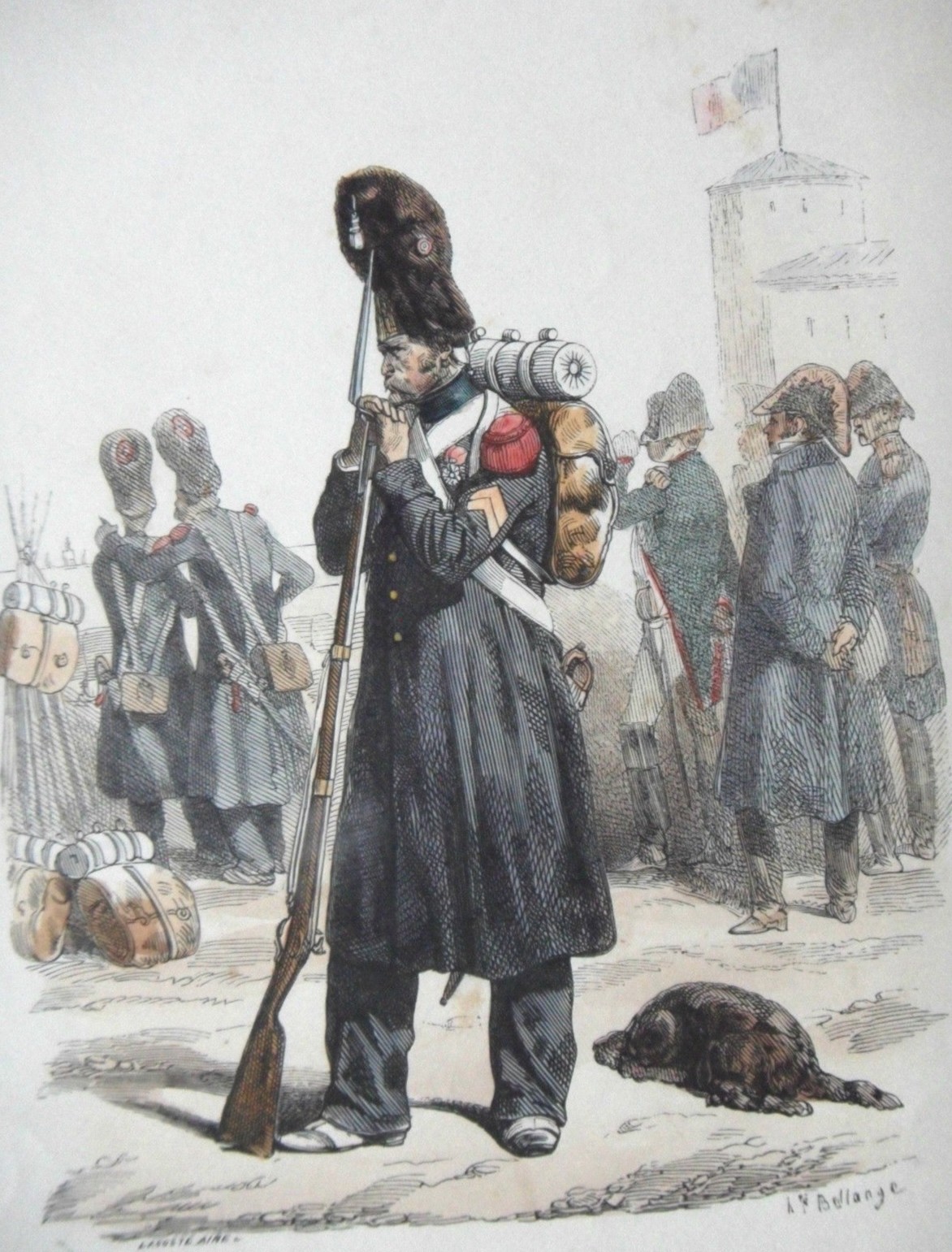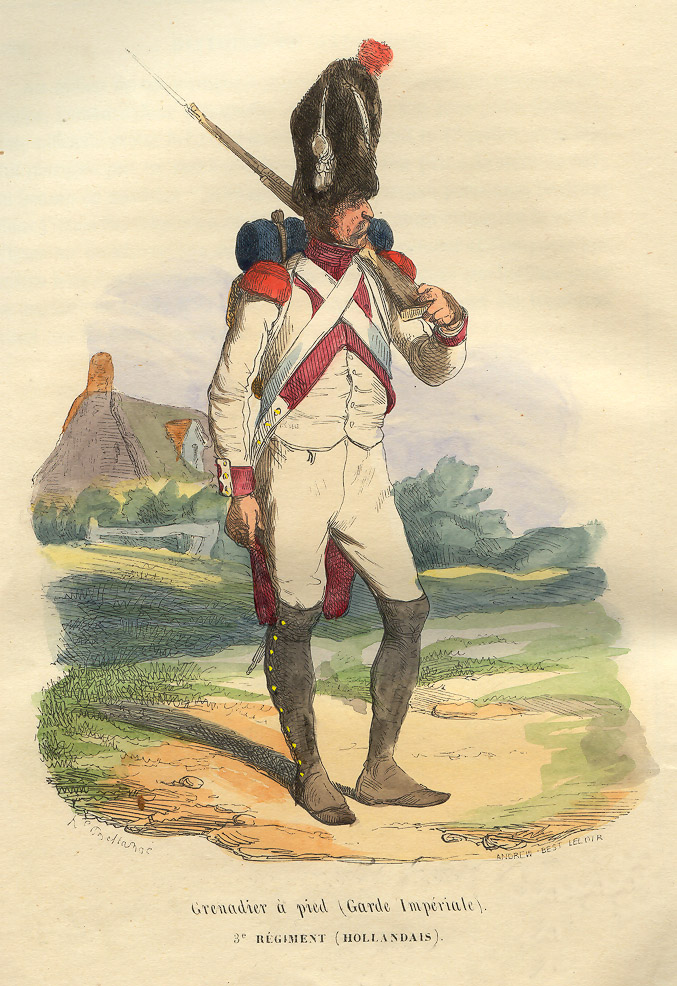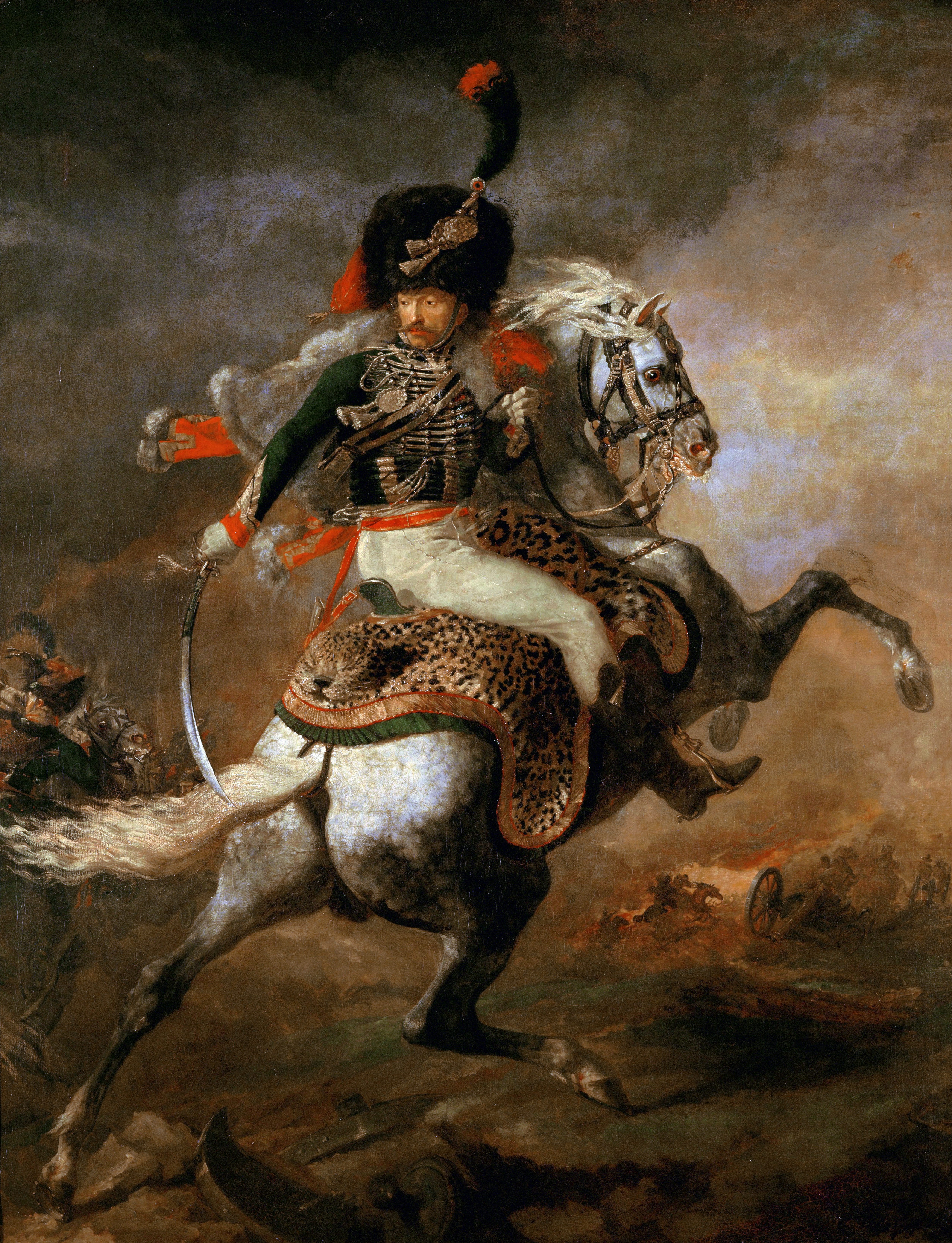 The Imperial Guard ( French: ''Garde Impériale'') was the imperial guard formation of the French Imperial Army. Under the direct command of
The Imperial Guard ( French: ''Garde Impériale'') was the imperial guard formation of the French Imperial Army. Under the direct command of History
 Napoleon took great care of his Guard, particularly the Old Guard. The Grenadiers of the Old Guard were known to complain in the presence of the Emperor, giving them the nickname ''Les'' ''Grognards'', the Grumblers. The Guard received better pay, rations, quarters, and equipment, and all guardsmen ranked one grade higher than all non-Imperial Guard soldiers. Other French soldiers even referred to Napoleon's Imperial Guard as "the Immortals".
The Guard played a major part in the climax of the
Napoleon took great care of his Guard, particularly the Old Guard. The Grenadiers of the Old Guard were known to complain in the presence of the Emperor, giving them the nickname ''Les'' ''Grognards'', the Grumblers. The Guard received better pay, rations, quarters, and equipment, and all guardsmen ranked one grade higher than all non-Imperial Guard soldiers. Other French soldiers even referred to Napoleon's Imperial Guard as "the Immortals".
The Guard played a major part in the climax of the  The Old Guard regiments were assigned to the Guard's 3rd Division, while the remainder of the Guard's foot regiments were assigned to the 1st and 2nd Divisions.
The Old Guard regiments were assigned to the Guard's 3rd Division, while the remainder of the Guard's foot regiments were assigned to the 1st and 2nd Divisions.
Numbers
In 1804, the Guard numbered 8,000 men. By the time of Napoleon's invasion of Russia in 1812, it had swelled to just under 100,000 men. The Guard had its own artillery, infantry and cavalry components just like a normal army corps. The Old Guard was the elite within the wider Imperial Guard.General Staff
Created soon after the creation of the Guard itself, the General Staff by 1806 included the four Colonel-Generals of the four divisions of the Guard, allFoot regiments
The Old Guard regiments served in the 3rd Division of the Guard, while the rest of the foot regiments of the Guard served in the 1st and 2nd Divisions.Old Guard
1st Regiment of Foot Grenadiers Musket
The 1st Regiment of Foot Grenadiers () was founded from the Consular Guard Grenadiers (), which had been formed from the Guards of the Directory. The battalion was made up of the Imperial French Army's most experienced and tallest men, and were essentially the army's most senior unit. One of two Imperial Guard battalions carried the Imperial Eagle into battle. After Napoleon's failure in the Invasion of Russia, only a few troops from the initial force remained, and the army had to be rebuilt using2nd Regiment of Foot Grenadiers
Raised in 1806 from veterans of the , the was a unit within the Middle Guard. This particular unit was disbanded in 1810 and was replaced by the so-called Dutch Grenadiers until in 1811, upon the upcoming invasion of Russia, the 2nd Regiment of Foot Grenadiers was reraised with 1,500 veteran soldiers. By 1813, the unit was designated to join the Old Guard as a reward of their long service in both Spain and Russia.3rd Regiment of Foot Grenadiers
 Originally raised as part of the Dutch Royal Guard when
Originally raised as part of the Dutch Royal Guard when 4th Regiment of Foot Grenadiers
The was the last grenadier guard regiment to be raised. Created on 9 May 1815, it saw action at Ligny and Waterloo. It was disbanded on 24 September 1815.Chasseurs
1st Regiment of Foot Chasseurs
 Being the second in seniority within the Imperial Guard Infantry, the was one of the most respected regiments within the ; classed as part of the Old Guard.
Being the second in seniority within the Imperial Guard Infantry, the was one of the most respected regiments within the ; classed as part of the Old Guard.
2nd Regiment of Foot Chasseurs
Raised in 1806, the was disbanded in 1809 and re-raised in 1811 for the invasion of Russia. As part of the Middle Guard, they engaged in numerous battles and by 1813 they were finally raised to be part of the Old Guard.3rd Regiment of Foot Chasseurs
The briefly existed during the 100 days campaign after Napoleon's escape from4th Regiment of Foot Chasseurs
The was also raised during the 100 days campaign after Napoleon's escape from Elba.Middle Guard
Fusiliers-Grenadiers
The Fusiliers-Grenadiers were the second regiment of Fusiliers created on 15 December 1806 from the 1st battalions of the Grenadier and Chasseur Vélites, forming a regiment that was to be 1,800 men strong. Conscripts and men from the Compagnies de Reserve brought the new regiment up to four battalions of four companies each, 120 men per company. They were disbanded on 12 May 1814.
Fusiliers-Chasseurs
The Fusiliers-Chasseurs were created on 19 October 1806 from the 1st battalions of the Vélites of the Grenadiers and Chasseurs of the Guard; the regiment was to be 1,200 men strong. Men of the Compagnies de Reserve were added to bring the regiment up to four battalions of four companies each, 120 men to a company. In 1813, each battalion was enlarged by two more companies. They were destroyed on 12 May 1814.Young Guard
Tirailleurs-Grenadiers
The first regiment to become known as the Young Guard, Tirailleurs Grenadiers () were raised in 1809 from conscripts, but they had to be able to read and write. A second regiment was formed later in the same year. In 1810 both were renamed '' & ''.Tirailleurs-Chasseurs
Two regiments of Tirailleurs-Chasseurs were formed at the same time as the Tirailleurs-Grenadiers, and were also included in the Young Guard. For the 1812 campaign in Russia these were expanded to six regiments. Both became ' ''& '' in 1811. During the 1813–14 campaigns the number of ' was increased to sixteen although they rarely equaled the regiments of the Young Guard of 1811. The 7th, 8th and 9th were recruited from the ' Pupilles de la Garde', childsoldiers who were to become Napoleon's son's guard and who stayed in France during the Napoleon's invasion of Russia.Voltigeurs
Created from the Tirailleurs-Chasseurs in late 1810, the ''Regiments de Voltigeurs de la Garde Impériale'' became one of the largest corps in the Guard, eventually absorbing the ''Regiments de Conscrits-Chasseurs'' to number sixteen regiments by 1814. The ''14e Régiment de Voltigeurs de la Garde Impériale'' was created from the Spanish volunteers that retreated with the French Army, and the ''Régiment de Voltigeurs de la Garde Royale Espagnol''.Conscripts-Grenadiers
Created in 1809, the two Conscripts-Grenadiers Regiments (''Régiment de Conscrit-Grenadiers''), though intended to provide a reserve for the Young Guard, were not included in the Guard, receiving line infantry pay. The regiments became ''3e & 4e Régiment de Tirailleurs de la Garde Impériale'' in 1810.Conscripts-Chasseurs
Created in 1809, the Conscripts-Chasseurs Regiment though intended to provide a reserve for the Young Guard, was not included in the guard, receiving line infantry pay. After 1811, the Conscrits-Chasseurs formed the 3rd and 4th regiments of the Voltigeurs of the Guard.National Guard Regiment of the Guard
This regiment was created from the National Guard companies of the northern departments of France. The regiment was organized according to the line infantry tables, and in 1813 was renamed the 7th Regiment of Voltigeurs.Flanqueur Grenadiers and Chasseurs
In preparation for the invasion of Russia, Napoleon ordered a further creation of units for the Guard that included ''Régiment de Flanqueurs-Grenadiers de la Garde Impériale'' and Flanqueur-Chasseurs Regiment (''Régiment de Flanqueurs-Chasseurs de la Garde Impériale'').Cavalry regiments
 The Imperial Guard cavalry constituted a corps in itself and had its own commander, with seasoned cavalrymen like Marshal Jean-Baptiste Bessières and generals Frédéric Henri Walther or Étienne Marie Antoine Champion de Nansouty successively at its helm. Augustin Daniel Belliard was also interim commander for a few days in 1814, before giving command to Horace François Bastien Sébastiani de La Porta, who held it for a short while, until Napoleon's abdication in April 1814. During the Hundred Days, there was no overall commander of the Guard cavalry, with command divided between Charles, comte Lefebvre-Desnouettes (light cavalry division) and Claude-Étienne Guyot (heavy cavalry division).
The Imperial Guard cavalry constituted a corps in itself and had its own commander, with seasoned cavalrymen like Marshal Jean-Baptiste Bessières and generals Frédéric Henri Walther or Étienne Marie Antoine Champion de Nansouty successively at its helm. Augustin Daniel Belliard was also interim commander for a few days in 1814, before giving command to Horace François Bastien Sébastiani de La Porta, who held it for a short while, until Napoleon's abdication in April 1814. During the Hundred Days, there was no overall commander of the Guard cavalry, with command divided between Charles, comte Lefebvre-Desnouettes (light cavalry division) and Claude-Étienne Guyot (heavy cavalry division).
Horse Grenadiers
The Horse Grenadiers was the senior cavalry regiment of the Guard, and originated from the Consular Guard. Classed as heavy cavalry, the regiment did not wear a cuirass, but was known for its distinctive bearskin head-dress and black horses. It was known by the nickname of "the Gods"; also as "the Big Heels".Chasseurs à Cheval
 The Regiment of Chasseurs a Cheval (''1er Régiment de Chasseurs-a-Cheval de la Garde Impériale'') was also created from the Consular Guard, and ranked second in seniority, although it was a light cavalry regiment. It was the Chasseurs that usually provided personal escort to Napoleon, and he often wore the uniform of the regiment in recognition of this service. The regiment was not only known for its lavish uniform, but its combat history, as well. A second regiment (''2e Régiment de Chasseurs-a-Cheval de la Garde Impériale'') was created briefly from ''Regiment d'Eclaireurs Lanciers'' in 1815.
The Regiment of Chasseurs a Cheval (''1er Régiment de Chasseurs-a-Cheval de la Garde Impériale'') was also created from the Consular Guard, and ranked second in seniority, although it was a light cavalry regiment. It was the Chasseurs that usually provided personal escort to Napoleon, and he often wore the uniform of the regiment in recognition of this service. The regiment was not only known for its lavish uniform, but its combat history, as well. A second regiment (''2e Régiment de Chasseurs-a-Cheval de la Garde Impériale'') was created briefly from ''Regiment d'Eclaireurs Lanciers'' in 1815.
Empress' Dragoons
 The dragoon regiments of the line distinguished themselves in the German campaign of 1805, and so Napoleon decided (in a decree of 15 April 1806) to reorganize the cavalry of the Guard and create within it a regiment of dragoons (''Régiment de Dragons de la Garde Impériale''), made up of three squadrons, headed by 60 officers personally selected by Napoleon. The first squadron was to have 296 men, and be made up of "vélites", whilst the other two were regular squadrons of 476 horsemen. To complete this new unit, each of the 30 dragoon regiments of the line provided 12 men, each of whom had done 10 years of service, and the brigadier, chasseur, and dragoon line regiments provided the ''sous-officiers''. This regiment quickly became known as the ''Régiment de dragons de l'Impératrice'' (the Empress' Dragoons) in tribute to their patroness,
The dragoon regiments of the line distinguished themselves in the German campaign of 1805, and so Napoleon decided (in a decree of 15 April 1806) to reorganize the cavalry of the Guard and create within it a regiment of dragoons (''Régiment de Dragons de la Garde Impériale''), made up of three squadrons, headed by 60 officers personally selected by Napoleon. The first squadron was to have 296 men, and be made up of "vélites", whilst the other two were regular squadrons of 476 horsemen. To complete this new unit, each of the 30 dragoon regiments of the line provided 12 men, each of whom had done 10 years of service, and the brigadier, chasseur, and dragoon line regiments provided the ''sous-officiers''. This regiment quickly became known as the ''Régiment de dragons de l'Impératrice'' (the Empress' Dragoons) in tribute to their patroness, Éclaireurs
In the Russian campaign of 1812, the French Army had suffered badly from attacks by the Russian1st (Polish) Regiment of Lancers
The regiment called the ''Régiment de Chevau-Légers Polonais de la Garde'' was created in 1807 after the 1806 defeat of the Allies, and the French creation of the2nd (Franco-Dutch) Regiment of Lancers
Raised in 1810 from former Dutch Army cavalry units as the ''2e Régiment de chevau-légers lanciers de la Garde Impériale'', the regiment became known as the Red Lancers from their uniform.3rd (Lithuanian) Regiment of Lancers
A Light Cavalry Lancers Regiment of the Imperial Guard () was raised inMamelukes
A squadron of Mamelukes (''Escadron de Mamelukes'') returned with Napoleon from the Egyptian Campaign in 1799. They were inducted into the Guard, and usually attached to the ''Chasseurs à Cheval''. The squadron was never increased to a regiment in strength. Over the years their casualties were replaced from French cavalry regiments, or from any vaguely Middle Eastern related nationalities.Elite Gendarmes
Although technically classed as cavalry of the Guard, ''Legion de Gendarmerie d'Elite'' troops invariably served in detachments with the General Staff of the Guard, Napoleon's personal headquarters, and the Guard field camps. The Legion included mounted and dismounted troops, the mounted component being two squadrons.Guards of Honour
The Guards of Honour (''Régiment de Garde d'Honneur'') were four regiments of light cavalry which Napoleon created in 1813 for his campaigns in Germany to reinforce his Guard cavalry decimated in Russia. The regiments were dressed in the fashion of the hussars. They served alongside the other Guard cavalry, but were not technically part of the Old, Middle or Young Guard.Artillery
 Artillery of the Guard included the Foot Artillery Regiment (''Régiment d'Artillerie à Pied de la Garde Impériale'') batteries, Horse Artillery Regiment (''Regiment d'Artillerie à Cheval de la Garde Impériale'') batteries, the Artillery Train of the Guard (''Train d'Artillerie de la Garde Consulaire'')two regiments in 1813 and the Artillery Park of the Guard (''Parc d'Artillerie de la Garde Impériale''), the latter two created in 1807. Despite shortages in artillery ordnance, in 1813 Napoleon created the ''Régiment d'Artillerie à Pied de la Garde Impériale'' of the Young Guard (''Jeune Garde''). The ''Parc du materiel de la Garde Impériale'' was created in 1813 to supplement the meager resources of the ''Bataillon du Train des équipages militaires'' after the losses of the 1812 campaign.
Artillery of the Guard included the Foot Artillery Regiment (''Régiment d'Artillerie à Pied de la Garde Impériale'') batteries, Horse Artillery Regiment (''Regiment d'Artillerie à Cheval de la Garde Impériale'') batteries, the Artillery Train of the Guard (''Train d'Artillerie de la Garde Consulaire'')two regiments in 1813 and the Artillery Park of the Guard (''Parc d'Artillerie de la Garde Impériale''), the latter two created in 1807. Despite shortages in artillery ordnance, in 1813 Napoleon created the ''Régiment d'Artillerie à Pied de la Garde Impériale'' of the Young Guard (''Jeune Garde''). The ''Parc du materiel de la Garde Impériale'' was created in 1813 to supplement the meager resources of the ''Bataillon du Train des équipages militaires'' after the losses of the 1812 campaign.
Engineers
Although not deployed in combat as a unit, the Engineers (''Genie de la Garde Impériale'') created in 1804 as the engineers of the Consular Guard, participated in combat more so than the combat units of the Guard which were usually held in reserve. By 1810 the Chief Engineer officer of the Guard had a company of ''Sapeurs de la Garde'' (140 sappers), all members of the Old Guard. In 1813 this was increased to two companies, and later one battalion of four companies totaling 400 sappers. The 1st and 2nd companies were classed as Old Guard, while the 3rd and 4th companies as the Young Guard.Sailors
Raised from sailors of the French navy who had distinguished themselves, the battalion of ''Marins'' wore a distinctive, elaborate uniform resembling that of theSee also
* Imperial Guard (Napoleon III) *Footnotes
External links
Infantry of Napoleon's Imperial Guard
{{Authority control Military units and formations established in 1804 Military units and formations disestablished in 1815 French military units and formations of the Napoleonic Wars Royal guards Army units and formations of France 1804 establishments in France 1815 disestablishments in France __FORCETOC__